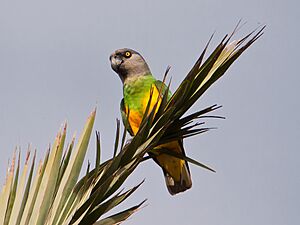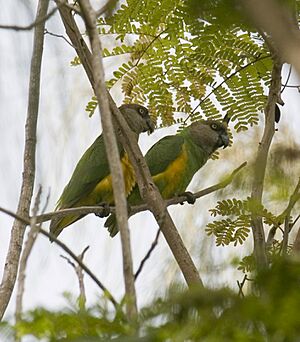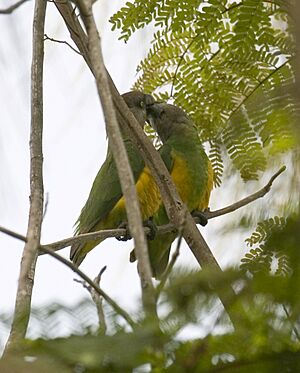Senegal parrot facts for kids
Quick facts for kids Senegal parrot |
|
|---|---|
 |
|
| Adult male in the Canary Islands, Spain | |
| Conservation status | |
| Scientific classification | |
| Genus: |
Poicephalus
|
| Species: |
senegalus
|
| Subspecies | |
|
|
 |
|
| Range | |
| Synonyms | |
|
Psittacus senegalus Linnaeus, 1766 |
|
The Senegal parrot (Poicephalus senegalus) is a colorful parrot that lives in West Africa. These birds move around West Africa to find their favorite foods, like fruits, seeds, and flowers. Sometimes, they eat crops like maize or millet, which can make them a problem for farmers. Many people also love to keep Senegal parrots as pets.
Contents
About Senegal Parrots
Senegal parrots are part of a group of parrots called Poicephalus. There are two main types, or subspecies, of Senegal parrots:
- P. s. senegalus: This type has a yellow "vest" on its chest. You can find them in countries like Senegal, Mali, and Guinea.
- P. s. versteri: This type has a deep orange or red "vest." They live in places like the Ivory Coast and Ghana.
These two types look a bit different in color, but they act the same. The yellow-vested type is more common as a pet.
What They Look Like
Senegal parrots are about 23 centimeters (9 inches) long. They usually weigh between 120 and 170 grams (4 to 6 ounces). They have a big head and beak for their size.
Their heads are charcoal grey, and their beaks are also grey. They have bright yellow eyes. Their backs and throats are green, and their bellies are yellow. The yellow and green colors on their front form a V-shape, which looks like a yellow vest. Young parrots have dark grey eyes, which turn light grey as they get older.
It can be tricky to tell if a Senegal parrot is a boy or a girl just by looking. But here are some ideas that might help:
- The V-shape of the "vest" is often longer in female parrots.
- Female parrots usually have slightly smaller and narrower beaks and heads.
- The feathers under a male's tail are mostly yellow, while a female's are usually green.
- Boys are often a bit bigger and heavier than girls.
- The best way to know for sure is through a special DNA test.
Senegal parrots live in open woodlands and savannas. They often gather in groups and are quite chatty. They make many whistling and squawking sounds. In the wild, they live for about 25 to 30 years. But in homes, they can live much longer, sometimes up to 50 years!
These parrots mostly eat fruit, which makes up about 77% of their diet. They love figs, African grapes, and shea fruits. Seeds are also a big part of their diet (about 22%), and they sometimes eat flowers.
Life Cycle and Behavior
Senegal parrots build their nests in holes inside trees, often in oil palm trees. A female parrot usually lays three to four white eggs. Each egg is about 3 centimeters (1.2 inches) long.
The mother parrot sits on the eggs to keep them warm. She starts after the second egg is laid, and it takes about 27 to 28 days for the eggs to hatch. When the chicks are born, they have a few white fluffy feathers. Their eyes stay closed for about two to three weeks.
The mother stays with her chicks to feed them and keep them warm. She does this until they have enough feathers to stay warm by themselves, which is around four weeks old. During this time, the father parrot brings food for the mother and the babies. He also guards the nest. After about two to four weeks, the mother also starts to find food for the chicks.
The young parrots learn to fly out of the nest when they are about 9 weeks old. They become fully independent from their parents at about 12 weeks old.
Protecting Senegal Parrots
It's hard to count all the wild Senegal parrots in Africa because they live in such a large area. However, people became worried in 1981 because so many wild parrots were being caught to be sold as pets.
Because of this, the Senegal parrot was added to a special list called CITES (The Convention on the International Trade in Endangered Species). This means it is now against the law to buy, sell, or trade wild-caught parrots. This rule helps protect them in their natural homes.
Senegal Parrots as Pets
Senegal parrots that are raised by humans from a young age are very popular pets. They are the most popular type of Poicephalus parrot. They make high-pitched whistles and squawks, and can even copy some sounds. But they are not as loud as many other parrot types.
They can be very friendly and make good companions. Senegal parrots also like to have their own time and need a lot of sleep during the day. If you have two as pets, it can help them stay happy and healthy because they have a friend.
It's important to know that wild-caught Senegal parrots usually do not become tame. They do not make good pets.
Breeding Parrots
Senegal parrots are fairly easy to breed when they are kept by humans. There are even businesses that breed and raise these parrots for the pet trade. In captivity, Senegal parrots can start having babies when they are 3 to 4 years old. Some might wait until they are 5. Parrots raised by their own parents might start breeding as early as 2 years old.
For breeding, a nest box can be about 45 centimeters (18 inches) tall and 20 to 25 centimeters (8 to 10 inches) wide. The entrance hole should be about 6.5 centimeters (2.5 inches) across. The parrots might chew the wood to make the hole bigger. Nest boxes usually have a door on the side so people can check on the nest.
Images for kids










